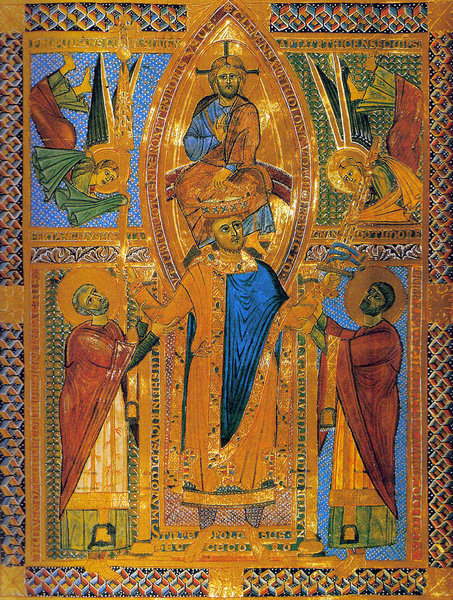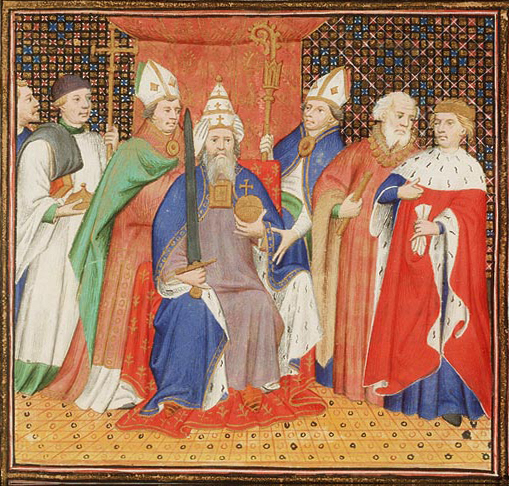<Back to Index>
- Dentist Chapin Aaron Harris, 1806
- Writer Willem Johannes Theodorus Kloos, 1859
- Holy Roman Emperor Henry II the Saint, 972
PAGE SPONSOR


Henry II (6 May 972 – 13 July 1024), called the Holy or the Saint, was the fifth and last Holy Roman Emperor of the Ottonian dynasty, from his coronation in Rome in 1014 until his death a decade later. He was crowned King of the Germans in 1002 and King of Italy in 1004. He is the only German king to have been canonized.
He was the son of Henry II, Duke of Bavaria.
As his father had rebelled against two previous emperors, he was often
in exile. This led the younger Henry to turn to the Church at an early
age, first finding refuge with the Bishop of Freising, and later being educated at the cathedral school of Hildesheim. He succeeded his father as Duke of Bavaria in 995 as Henry IV. Henry was on his way to Rome to save his besieged cousin the Emperor Otto III when
the emperor died in January 1002. Knowing that opposition to his
succession was strong, Henry quickly seized the royal insignia from his
dead cousin's companions. Rival candidates for the throne — such as Ezzo of Lotharingia, Eckard I of Meissen, and Herman II of Swabia — strongly contested Henry's succession, but with the aid of Willigis, Archbishop of Mainz, he was able to secure his royal election and coronation on June 7, 1002 in Mainz, though it would be a year before he was universally recognized. Henry spent the next several years consolidating his political power on his borders. He waged a campaign against Boleslaw I of Poland and then moved into the Kingdom of Italy to confront Arduin of Ivrea,
who had been elected King of Italy by a faction opposed to Henry.
Arduin had previously defeated a German army sent against him by Henry
and commanded by Otto I of Carinthia. Now he tried to block the German king in the Adige valley, as he had previously done with Otto, but Henry entered Italy at the Valsugana. Arduin's vassals fled in disarray at Henry's approach and their king was forced to return to the March of Ivrea. Henry occupied Verona and was crowned rex Italiae (King of Italy) at Pavia on May 15, 1004, by the Archbishop of Milan, Arnulf II, with the famous Iron Crown.
After
bloodily suppressing a revolt of the citizens of Pavia, Henry remained
there until May 25, when, feeling that Italy could be considered settled, he decided to return to Germany through the Saint Gotthard Pass. From Germany he launched a second campaign against Boleslaw, allying with the pagan Liutitians against
the Christian Poles. The expedition was unsuccessful and culminated in
a lasting peace with the Poles in 1018 agreed to at Bautzen: Boleslaw retained Lusatia and Meissen (possibly as fiefs), but had to give up Bohemia, which he had recently conquered.
Henry
was called to Italy by the clergy for another campaign in 1013. Arduin
had risen in revolt again. At first he tried to resist Henry from his
palace in Ivrea, but then resigned to become a monk. Subsequently Henry went straight to Rome, where Pope Benedict VIII crowned him Holy Roman Emperor on February 14, 1014. He took his duties in
Italy seriously and appointed German officials to administer the
country. He returned in Germany in May.
In 1020, the pope visited him at Bamberg and consecrated his new cathedral there. After settling some controversies with the bishops of Mainz and Würzburg, Pope Benedict VIII convinced him to return to Italy for a third (and final) campaign to counter the growing power of the Byzantine Empire in the south, where the Lombard princes had made submission to the Greeks. In 1022, he set out down the Adriatic coast for southern Italy commanding a large force. He sent Pilgrim, Archbishop of Cologne, ahead with a slightly smaller army along the Tyrrhenian littoral with the objective of subjugating the Principality of Capua. A third army, smaller still, under the command of Poppo, Patriarch of Aquileia, went through the Apennines to join Henry in besieging the Byzantine fortress of Troia. Pilgrim did capture Pandulf IV of Capua and extract oaths of allegiance from both Capua and the Principality of Salerno, but all three divisions failed to take Troia. Henry almost executed the
treacherous prince of Capua, but relented at the last moment at
Pilgrim's pleading and instead sent him off to Germany in chains and
appointed Pandulf of Teano to
replace him as prince. Though his main objective had been missed, Henry
left the south in the knowledge that western imperial authority still
extended that far. On his return journey, he attended a synod at Pavia
where he advocated Church reform. Henry's
most significant contributions as emperor came in the realm of
church - state relations and ecclesiastic administration within the
Empire. He supported the bishops against the monastic clergy and aided
them in establishing their temporal rule over broad territories. He
strongly enforced clerical celibacy in
order that the public land and offices he granted the church would not
be passed on to heirs. This ensured that the bishops remained loyal to
him, from whom they received their power, and provided a powerful
bulwark against rebellious nobles and ambitious family members. Henry
founded the Diocese of Bamberg, which quickly became a center of scholarship and art, in 1007. Henry had been working with the pope to call a Church Council to
confirm his new system of politico - ecclesiastical control when he
died suddenly in 1024, leaving this work unfinished. Henry and his wife, Cunigunde of Luxemburg, had no children, because they had taken a mutual vow of chastity.
Henry was
canonized in July, 1147 by Pope Clement II; and his spouse, Cunigunde, was canonized in the year 1200, by Pope Innocent III. His relics were carried on campaigns against heretics in the 1160s. Henry is buried in Bamberg Cathedral, which also has the tomb of Pope Clement II. He is the patron saint of the city of Basel, Switzerland, and of St Henry's Marist Brothers' College in Durban, South Africa.
Saint Henry's name, which does not appear in the Tridentine Calendar, was inserted in 1631 in the Roman Calendar as a commemoration within the celebration of Saint Anacletus on
13 July, the day of his death and the traditional day for his
celebration on a local level. In 1668, it was moved to 15 July for
celebration as a Semidouble. This rank was changed by Pope Pius XII in 1955 to that of Simple, and by Pope John XXIII in 1960 to that of Third - Class Feast. In 1969, it was returned to its original date of 13 July as an optional Memorial.
Between 1012 and 1018
Thietmar of Merseburg wrote a Chronicon, or Chronicle, in eight books, which deals with the period between 908 and 1018. For the earlier part he used Widukind's Res gestae Saxonicae, the Annales Quedlinburgenses and
other sources; the latter part is the result of personal knowledge. The
chronicle is nevertheless an excellent authority for the history of Saxony during the reigns of the emperors Otto III and
Henry II. No kind of information is excluded, but the fullest details
refer to the bishopric of Merseburg, and to the wars against the Wends and the Poles.